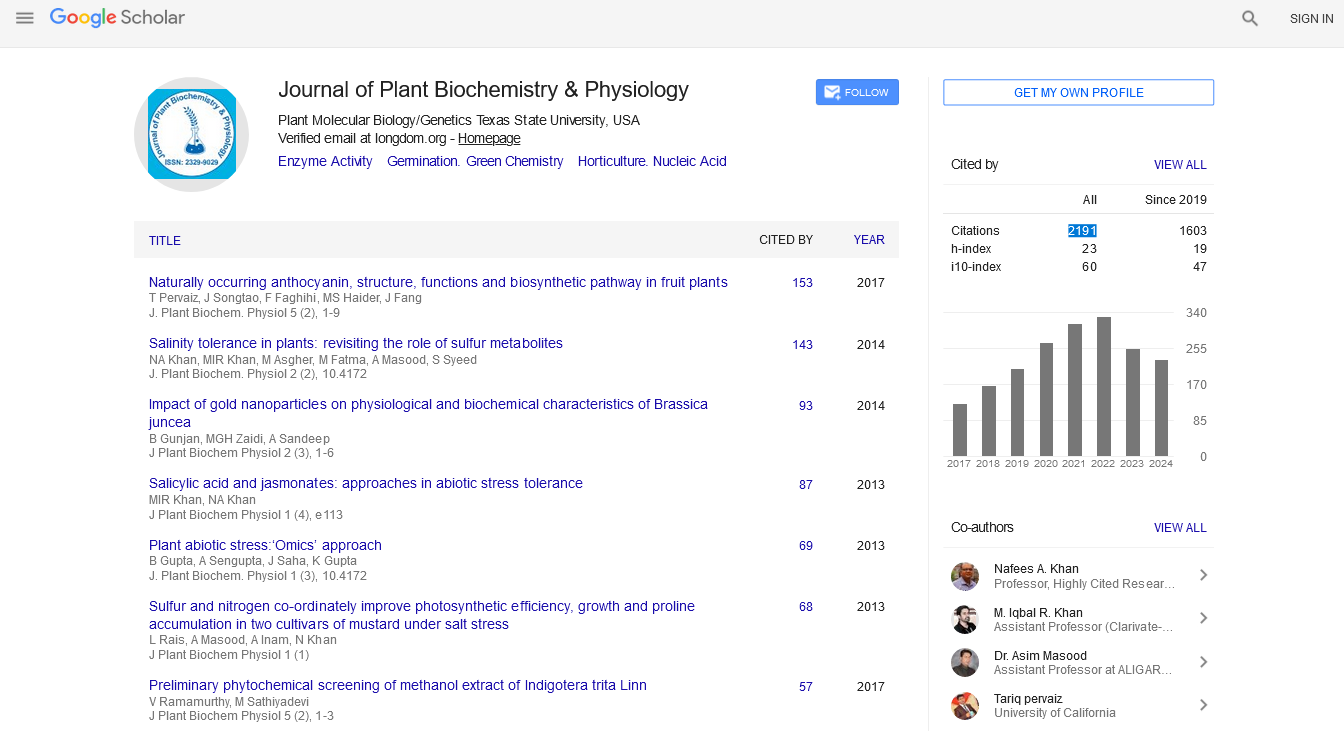Journal of Plant Biochemistry & Physiology : Citations & Metrics Report
Articles published in Journal of Plant Biochemistry & Physiology have been cited by esteemed scholars and scientists all around the world. Journal of Plant Biochemistry & Physiology has got h-index 29, which means every article in Journal of Plant Biochemistry & Physiology has got 29 average citations.
Following are the list of articles that have cited the articles published in Journal of Plant Biochemistry & Physiology.
| 2024 | 2023 | 2022 | 2021 | 2020 | 2019 | 2018 | 2017 | 2016 | 2015 | 2014 | 2013 | |
|---|---|---|---|---|---|---|---|---|---|---|---|---|
Total published articles |
44 | 30 | 60 | 36 | 14 | 17 | 23 | 29 | 11 | 24 | 30 | 35 |
Research, Review articles and Editorials |
10 | 4 | 32 | 13 | 2 | 17 | 23 | 28 | 6 | 23 | 28 | 29 |
Research communications, Review communications, Editorial communications, Case reports and Commentary |
0 | 26 | 24 | 23 | 13 | 0 | 0 | 1 | 1 | 1 | 2 | 6 |
Conference proceedings |
15 | 0 | 0 | 0 | 0 | 0 | 47 | 0 | 0 | 0 | 0 | 0 |
Citations received as per Google Scholar, other indexing platforms and portals |
219 | 254 | 327 | 314 | 269 | 208 | 166 | 123 | 128 | 101 | 39 | 0 |
| Journal total citations count | 2191 |
| Journal impact factor | 4.25 |
| Journal 5 years impact factor | 5.03 |
| Journal cite score | 4.78 |
| Journal h-index | 29 |
| Journal h-index since 2019 | 19 |
Important citations (595)
responses triggered in chloroplast of chlorella variabilis nc64a by long-term association with paramecium bursaria |
|
sharma p, bhardwaj p, arif t, khan i, singh r (2014) research and reviews: journal of pharmacology and toxicological studies. |
|
dhir b (2016) municipal sludge: an effective soil supplement for improving plant growth. indian journal of plant physiology 21: 213-218. |
|
medicinal plant tulasi and its uses |
|
baba-induced resistance: milestones along a 55-year journey |
|
total crude protein extract of trichoderma spp. induces systemic resistance in pearl millet against the downy mildew pathogen |
|
dominant groups of potentially active bacteria shared by barley seeds become less abundant in root associated microbiome |
|
protease encoding microbial communities and protease activity of the rhizosphere and bulk soils of two maize lines with different n uptake efficiency |
|
hippophae rhamnoides l. rhizobacteria exhibit diversified cellulase and pectinase activities |
|
analysis of fatty acid compositions and differential gene expression in two iranian olive cultivars during fruit ripening |
|
piero nm, joan mn, richard oo, jalemba ma, omwoyo or, et al. (2015) determination of cyanogenic compounds content in transgenic acyanogenic kenyan cassava (manihot esculenta crantz) genotypes: linking molecular analysis to biochemical analysis. journal of analytical & bioanalytical techniques 6: 1. |
|
pravallika s (2016) research & reviews: journal of medical and health sciences. |
|
biochemical, transcriptional, and bioinformatic analysis of lipid droplets from seeds of date palm (phoenix dactylifera l.) and their use as potent sequestration agents against the toxic pollutant, 2,3,7,8-tetrachlorinated dibenzo-p-dioxin. |
|
if photoinhibition of soybean photosystem ii enhances the hypersensitiveresponse, it is not solely due to blockage of electron transfer flow at d1 |
|
improving grain yield and protein concentration of maize (zea mays l.) simultaneously by appropriate hybrid selection and nitrogen management |
|
saponin seed priming improves salt tolerance in quinoa |
|
ascorbic acid triggered physiochemical transformations at different phenological stages of heat-stressed bt cotton |
|
ethnopharmacological uses, phytochemistry and pharmacological activities of guiera senegalensis j.f. gmel. (combretaceae). |
|
fluorine: a biohazardous agent for plants and phytoremediation strategies for its removal from the environment |
|
surveying the potential of secreted antimicrobial peptides to enhance plant disease resistance. |
|
